D.C.’s best bar talent takes on NOLA for the world’s biggest cocktail conference.
Story and photos by Kelly A. Magyarics
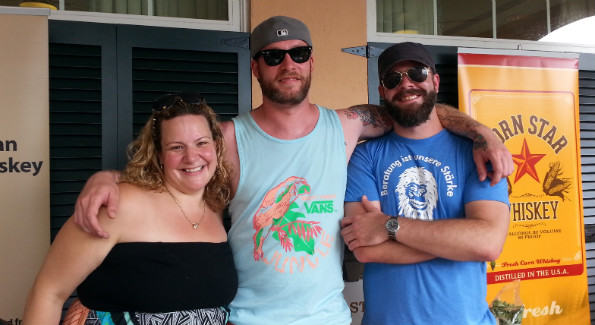
Gina Chersevani, Owen Thomson and Ben Wiley mix up drinks for a Whiskey Luau at Tales of the Cocktail.
You may or may not have heard that last week was Tales of the Cocktail, the 11th annual conference that takes place in New Orleans each July and attracts bartenders, industry insiders and cocktail enthusiasts from all around the world. Attendees head to seminars, tasting rooms, spirited dinners, special receptions and other events designed to promote and introduce spirit brands and other drink ingredients. There is so much to see and do, each time I go I think how helpful it would be to have a clone or two so I could make it to more events. (Yes, I realize that’s a first-world drinks writer’s problem…)
Washington was well-represented at Tales. Here are highlights of what some of our town’s top talent got into in New Orleans, as I saw it. (If I missed anyone or anything, I apologize.)
For starters, this year’s official cocktail was none other than D.C.’s native drink the Rickey. Bartenders from around the country were invited to submit their own version of the drink, described as “a swizzle meets a highball.” Submitted recipes had to be tart, have a carbonated element and be refreshing. It is a drink after all, as Derek Brown puts it, that is “air conditioning in a glass,” perfect for sipping — or gulping — during a hot and sticky D.C. (or New Orleans) summer. Cocktails were judged on originality, use of the product, taste and presentation by Passenger/Columbia Room’s and Mockingbird Hill‘s Derek Brown, Proof and Estadio’s Adam Bernbach and Jeffrey Morganthaler of Clyde Common in Portland, Oregon. The winner received $1,250 cash and bragging rights for having Tales’ official sip. Unfortunately, no D.C. contenders made it to the finals. But the winning drink, created by Jacob Grier of Metrovino in Portland, Ore. and called (what else?) the Portland Rickey, was quite tasty. I loved the herbal element that the Green Chartreuse lends.
The Portland Rickey
Recipe courtesy of Jacob Grier
1 ½ oz. Martin Miller Gin
¾ oz. Lemon juice
¼ oz. Green Chartreuse
4 oz. Le Merle Saison
Squeezed half of lemon, for garnish
Combine the gin, Chartreuse, lemon and beer in an ice-filled highball glass. Drop the squeezed half-lemon into the drink, and gently stir. Garnish with a squeezed half of lemon, stirred into the drink.
Phil Greene, lawyer, D.C. resident, treasurer and legal counsel for the Museum of the American Cocktail and author of the book “To Have and Have Another: A Hemingway Cocktail Companion,” presented a seminar with Alexandre Gabriel, president and owner of Cognac Ferrand. The seminar combined cocktail legend and lore, classic drinks and literary quotes and references from Hemingway, Fitzgerald and other legendary writers of the 1920s. Greene talked about how American writers flocked to Paris after World War I, both to avoid Prohibition and to escape feelings of ennui, suffocation and the stifling post-war atmosphere. Of course, most spent many hours in the City of Light’s cafes and bars in Montparnasse, including La Rotonde, Le Dome and La Coupole. William Faulkner wisely stated that “civilization begins with distillation,” and each writer had his or her preferred potent potable. Greene and Gabriel shared a variation on the classic Jack Rose cocktail, and speculated that this is the drink that the main character Jake Barnes drinks in Chapter 6 of “The Sun Also Rises” while waiting for Brett Ashley. The recipe is found in a well-known 1920s bartender’s book called “Cocktails and Barflies” by Harry MacElhone, the owner of Harry’s New York Bar, which Hemingway was known to frequent.
Jack Rose: Harry MacElhone’s 1920s Parisian version:
1 ½ oz. Applejack or Calvados
¾ oz. Dry gin
¾ oz. Orange juice
¾ oz. Lemon or lime juice
1/3 oz. Dry Vermouth
1/3 oz. Sweet Vermouth
Grenadine to color (about 1/3 oz.)
Twist of lemon or lime, for garnish
Add all except garnish to a cocktail shaker. Add ice, and shake until chilled. Strain into a chilled cocktail glass, and garnish with the lemon or lime twist.
Gina Chersevani of Buffalo and Bergen, Hank’s Oyster Bar and Eddy Bar mixed up a frozen concoction (with the help of Owen Thomson and Ben Wiley of Range) for the Whiskey Luau party held at the rooftop pool of the Hotel Monteleone. The thirst-quenching tipple, called “Byrhhhh…I am Freezing,” combined Redemption Rye, ginger, mint and lemon, and was topped with Byrrh, a French aperitif made with red wine, mistelle (alcohol added to partially fermented grape juice) and quinine (the bark that gives tonic its signature bitterness.) Maybe I’m a little locally biased, but that drink was by far the best one on the rooftop that afternoon, and the only one for which I returned for a second glass.
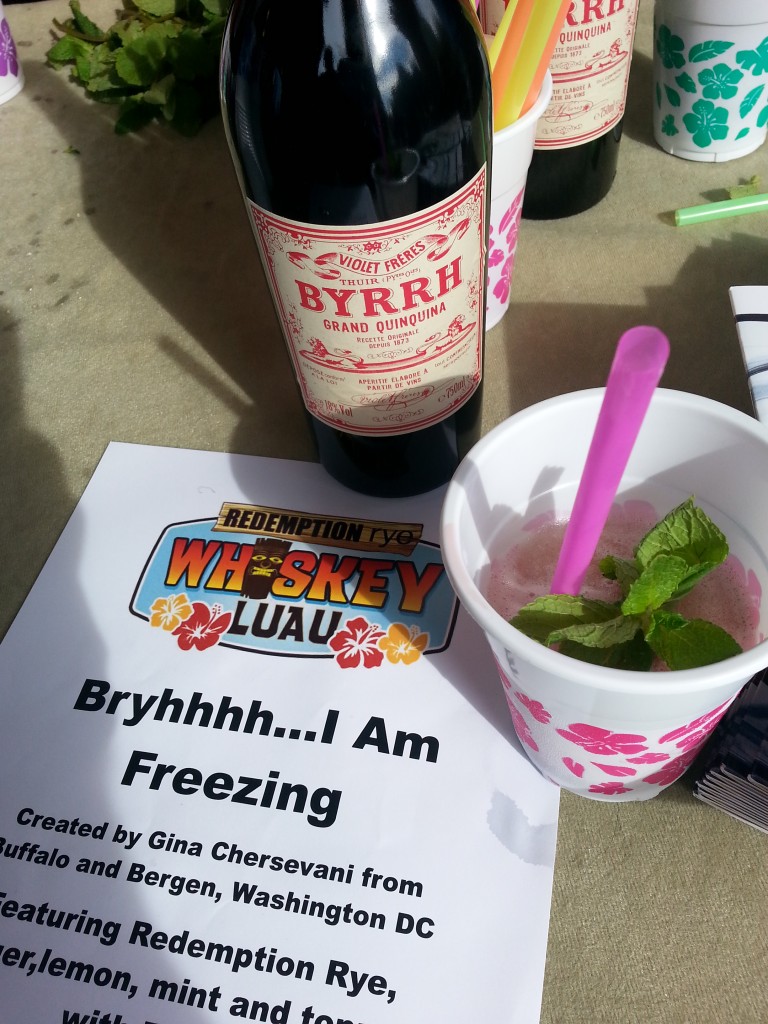
Gina Chersevani’s “Byrhhh…I am Freezing” was the most refreshing sip at the Whiskey Luau bash.
Speaking of Chersevani, she was one of five honorees at the second Dame Hall of Fame Luncheon. Organized and hosted by LUPEC (Ladies United for the Preservation of Endangered Cocktails), the lunch honored five women for their contributions to the cocktail arts. The Pioneer Award was given to Julie Reiner, co-owner and beverage director of New York’s Flatiron Lounge and Clover Club. Other inductees were Eryn Reece, bartender at Mayahuel and Death + Company, Bridget Albert, president of the U.S. Bartenders Guild National Charity Foundation and Meaghan Dorman, head bartender at The Raines Law Room. I’ve known Gina since she was making awesome drinks at EatBar, and this award is well-deserved. Congratulations Gina!
Though I couldn’t attend because of a scheduling conflict, Derek Brown helped to facilitate a seminar titled “Paleococktails.” Spring-boarding from the notion that mixed drinks were discovered as early as 7,000 BCE in China, where people mixed rice wine, botanicals, honey and fruit, this seminar explored the earliest alcoholic beverages, who mixed them and how they contributed to a society’s achievements in music, religion and agriculture. The panelists discussed how bartenders and cocktail enthusiasts today can apply these ancient lessons to a craft that’s now over 9,000 years old (in other words, much, much older than the first printed reference to a “cocktail,” which was in 1806.)
(And, on a side note, Derek and Chantal Tseng‘s Mockingbird Hill was cited by presenter Camper English during a Sherry Seminar as one of the top spots to get Sherry in the country. Drink more sherry, people!)
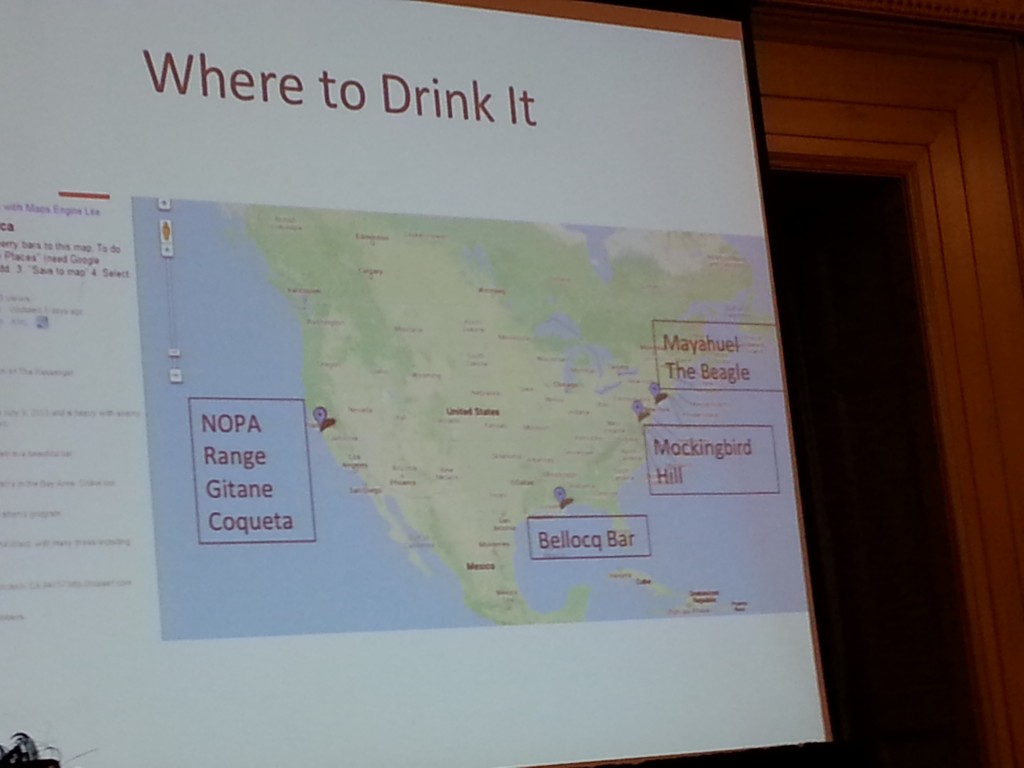
Derek Brown and Chantal Tseng’s bar Mockingbird Hill was cited as one of the top spots in the country to get Sherry.
Jason Wilson, author of “Boozehound,” the upcoming series “Planet of the Grapes” and the former spirits columnist for the Washington Post moderated a cool seminar on grape-based spirits Armagnac, Pisco and G’Vine (a French grape-based gin). So what does this category add to a cocktail? Mainly, smoothness and mouthfeel. The panelists, which included American Armagnac Ambassador (and my good friend) May Matta-Aliah, spoke about the importance terroir plays with grape-based spirits. Since 2002, sales of Brandy and Cognac have increased by 44 percent, yet those (and other aged grape-based options are still not used in many cocktails. Wilson speculated that it may be due to the category’s affiliation with “bling” and luxury, or its reputation of being stuffy, or its confusing labeling, or a combination of all three. We had the chance to sample the spirits by themselves, as well as in cocktails like the G’Vine Martini, with dry Vermouth, dry white wine and orange bitters; and the Martinez-like Vice and Virtue, with Pisco, Islay Scotch, Yellow Chartreuse, agave and Angostura bitters.
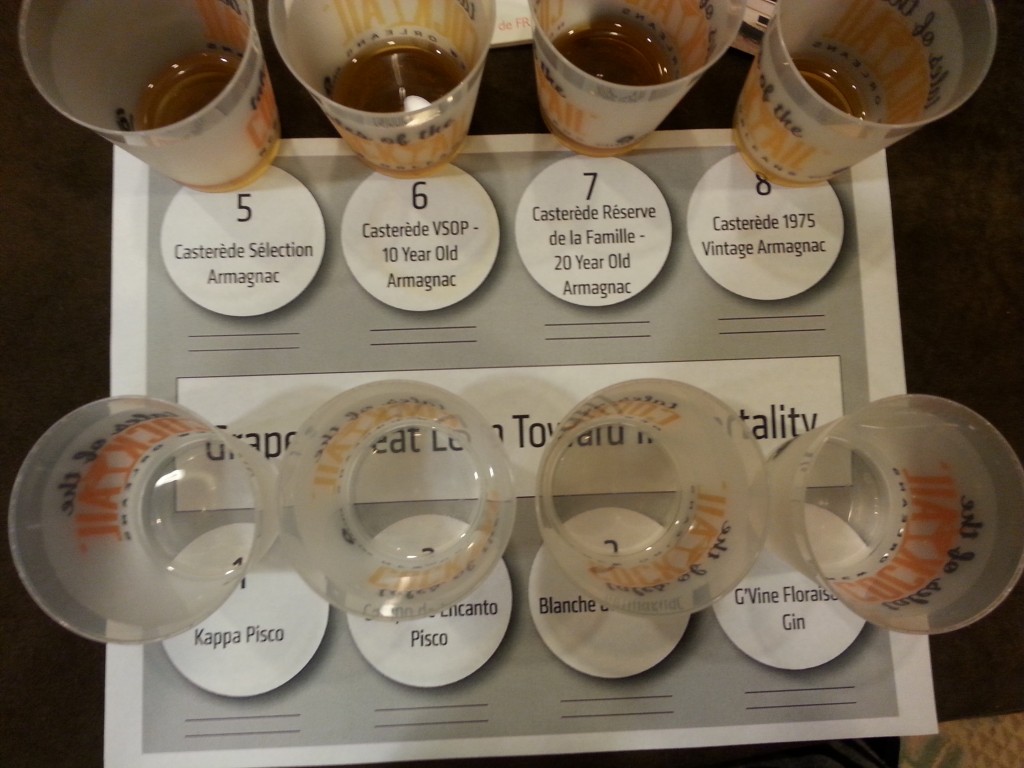
Tasting line up for the “Grapes’ Great Leap Toward Immortality” seminar.
Tales’ attendees had the chance to participate in one of many Spirited Dinners held on Thursday evening at restaurants all around the city. Phil Greene hosted one at the Hotel Monteleone dubbed “Libations in the Stream — Hemingway’s Conch, Cuban and Caribbean Cocktails and Cuisine,” while Gina Chersevani helped with a gin versus whiskey dinner at Windsor Court called “Beauty vs. the Beast.” I attended a dinner aboard the riverboat the Creole Queen called “Ebony Behind the Ivory,” a tribute to Douglas Ankrah, a legendary London bartender whose influence on the cocktail scene can still be felt today. Derek Brown helped organize the event, which included Bourbon Steak’s Duane Sylvestre mixing up a Bramble with Bombay Sapphire Gin, lemon juice and Crème de Mure.
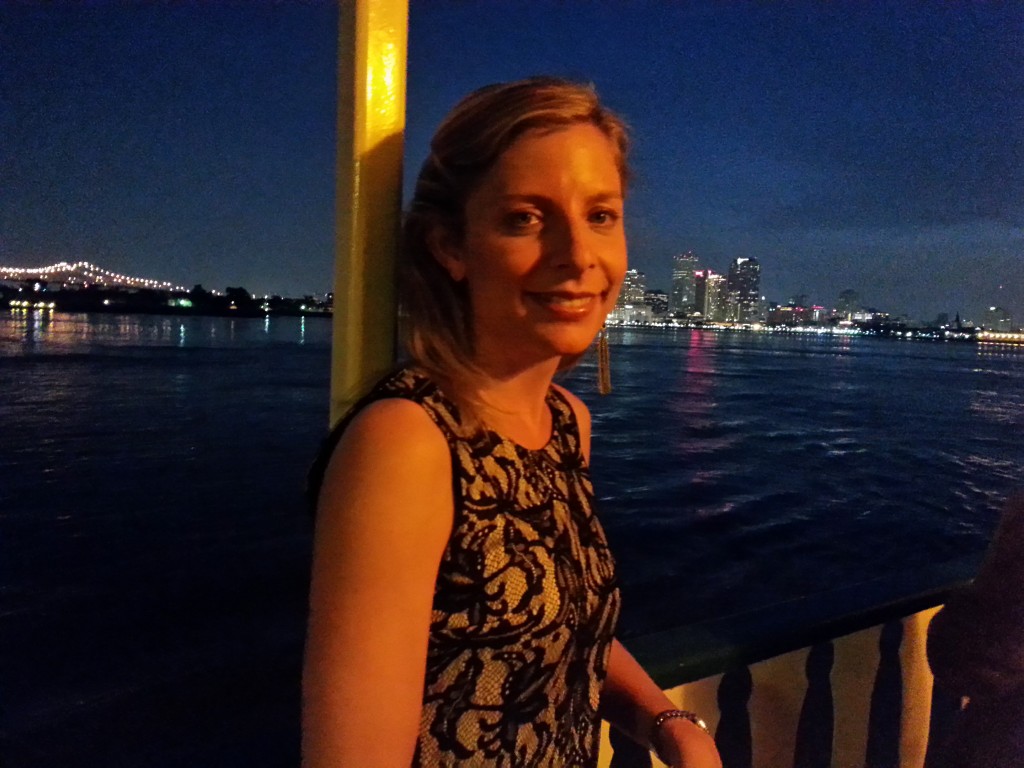
I’m on a boat! The Spirited Dinner on the Creole Queen honored black bartenders including London’s Douglas Ankrah.
And last but certainly not least, spirits specialist, author of the book “The Punch Bowl”, and vice president of the D.C. Craft Bartenders Guild Dan Searing was one of two bar chefs, along with David Ortiz, on the American Ingenuity Transport, a bus safely transporting Tales guests each evening to and from two of NOLA’s best cocktail bars: Cure and Bellocq. (I went to Bellocq one night and had a damn fine Bonal Cobbler.) On the bus, guests were treated to innovative cocktails from Searing and Ortiz, including Gin and Bourbon Rickeys, and the Brandy-based Hour Glass.
For more information about Tales of the Cocktail, which will be held again next July, visit www.talesofthecocktail.com.
Kelly Magyarics is a wine and spirits writer, and wine educator, in the Washington, D.C. area. She can be reached through her website, www.kellymagyarics.com, or on Twitter @kmagyarics.
